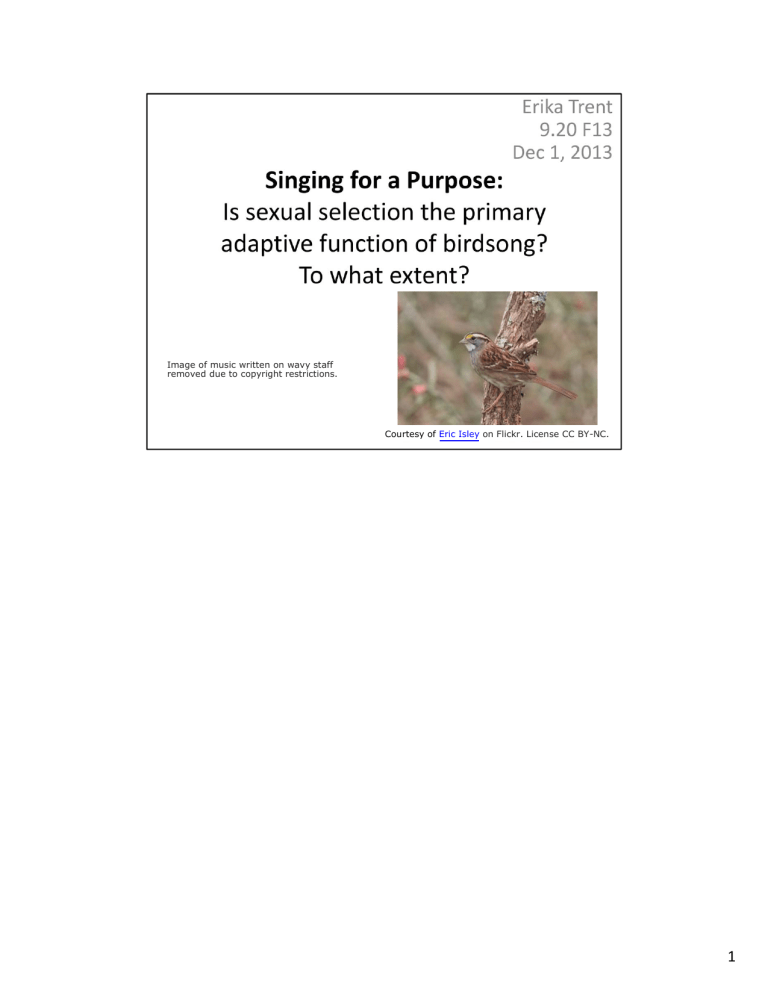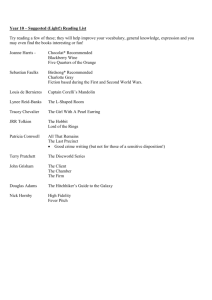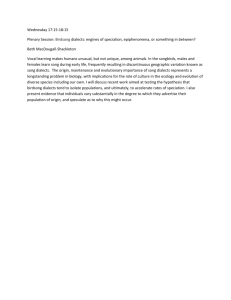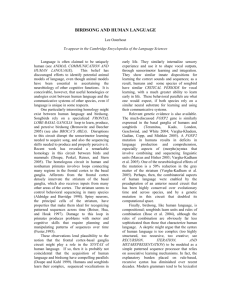Courtesy of Eric Isley I mage of music written on wavy staff

I mage of music written on wavy staff removed due to copyright restrictions.
Courtesy of Eric Isley on Flickr.
License CC BY-NC.
1
Courtesy of NASA.
Image is in public domain.
Courtesy of NOAA. Image is in public domain.
Courtesy of Duncan Rawlinson on Flickr. License CC BY-NC.
Cou r tesy of David A. La Puma on
Wikimedia Commons. License CC BY.
• Vocal music is a behavior exhibited by various species of animals.
Examples of animals that engage in vocal music behavior:
- Sea creatures, such as
- Whales
- Bottleneck dolphins
- Seals
- Various species of birds
- Parrot
- Cockatoo
- Cranes
- Hummingbirds
• Ethologists have termed such animal communication systems as “song”, because of their musical nature.
• Why? Their “songs” feature contours of pitches (shapes of melody), recognizable patterns, and rhythmic structure.
2
Figure removed due to copyright restrictions. Reference: Figure 1 from Baker, Myron C.
"Bird song research: the past 100 years." Bird Behavior 14, no. 1 (2001): 3-50.
A sonogram of two songs of buntings, which illustrates the musical characteristics of birdsong.
E.g. patterns, melodic contour, sense of rhythm. Terms used here are “notes”, “syllables,”
“phrases”
3
Given the time constraints of this presentation, I’ll focus on one type of vocal music behavior in animals: the birdsong.
Why does the bird sing?
We can examine this question through Tinbergen’s four questions on Causation,
Development, Evolution, and Functionality.
1. Causation
• In other words, what is the proximate cause of birdsong.
• Birds have a complex vocal organ, as well as neural circuits in their brains that are activated when their hormonal levels are high. These neural circuits synapse onto the vocal muscles, causing a “song” to be produced.
2. Development
• In terms of how the birdsong develops in each bird, birds are raised in an environment full of songs particular to their conspecifics (that is, birds of the same species as them)
• There are many studies that show that birdsong is, to a large extent, learned by young chicks at a young age, by mimicking their mothers or other conspecifics.
• Practice and learning establishes the neural connections we discussed in
“Causation”.
3. Evolution
• Syrinx = in the chest, at base of trachea and between lungs. Devoted entirely to sound making. (Suthers 1999)
4
• All birds share a similarly shaped syrinx. Possessing a syrinx distinguishes them from other vertebrates (a feature that all birds have, and that only birds have)
• indicates that this unique vocal organ evolved near the beginning of bird evolution.
But the question that has been subject to more debate, and the question we’ll be delving into today, is: What is the function of birdsong?
4
Image is in public domain.
A diagram of the bird syrinx. Located in between lungs. Syrinx is critical for song production, as McDonald 1989 demonstrate (this experiment will be explained later in the presentation).
5
• What is the function of birdsong? In other words, what is the ultimate cause?
• In terms of what we know about evolution and Darwinian selection, birds most likely sing because their ancestors who sang out-reproduced those who didn’t.
• But “WHY” did singers out-reproduce the non-singers is the big question.
• Until recently, it had been believed that sexual selection was the only reason for birdsong (i.e. males sing to attract females).
• However, more recent research has indicated that vocal music in birds may have more far-reaching purposes, including strengthening pair bonds, cementing other social bonds
(family, group bonds), and territorial defense.
• Let’s examine the evidence supporting each hypothesis, to determine which is most compelling.
• Where does sexual selection fall, in comparison with other possible adaptive functions?
6
Sexual Selection as the function of birdsong
- Past researchers, including Darwin, have claimed that vocal music behavior developed in animals as an adaptive function for sexual selection (Darwin 1871)
- Ethological research has supported Darwin’s hypothesis that most birdsong functions as a courtship display to attract mates (Catchpole & Slater)
- (this was a big step beyond previous unscientific, unfounded theories by natural theologians such as William Paley, who claimed that birdsong had no function for the animals themselves, but were only “miracles” bestowed to humans by some higher divine force)
- The hypothesis that sexual selection is the main function of birdsong is supported by the following points of evidence:
- Male birds sing much more than females
- Songs are sung mostly in breeding season
- male singing ability is a good predictor of their fitness
- Males sometimes drop dead from exhaustion from singing too much during breeding season – this male sacrifice suggests that the function of birdsong is not to enhance survival but to increase their likelihood of leaving offspring
7
• Some researchers took a broader approach, and asked whether general social communication and bonding may be the main function of birdsong.
• Birdsong signals, sent between conspecifics, tend to fall within a small number of distinct categories (Hauser 1996)
• Warning calls exchanged between kin (to signal a dangerous predator)
• Contact calls between group members (so that the group stays together when flying)
• Dominance/submission signals between conspecifics
• How do these functions compare to sexual selection, the function we just discussed earlier?
• Birdsong specific to courtship purposes is more prolonged in duration, more complex and varied in pitches, and more energetically expensive (expensive enough that males can die of exhaustion).
• Sexual selection appears more significant, as a function for birdsong, than other broader social communication signals.
8
Image of small music notes removed due to copyright restrictions.
Courtesy of Eugene Archer on
Flickr. License CC BY-NC.
.
Nikodimov on
Flickr. License CC BY-NC.
Courtesy of Johnnie
Walker on Flickr.
License CC BY-NC
Courtesy of Nikodimov on Flickr.
License
CC BY-NC .
• Two pieces of supporting evidence
• 1.
• Remove male from territory. If nothing is done, other males will rapidly invade the now-empty territory. (Falls 1988)
• However, if replace place a loudspeaker playing the male’s song, his empty territory will be invaded less rapidly by other males.
• (However, this study is not completely compelling because its comparing silence with song. It could very well may be that other males do not invade the loudspeaker-placed territory simply because it would be more difficult to invade a space they think is occupied by another male)
• 2. More compelling study: “selective muting experiment” (McDonald 1989)
• Make a tiny puncture in air sac surrounding syrinx of sparrows. Makes them unable to produce full song, but their ability to produce normal calls is intact.
• These males were slower at obtaining territories, and were less able to retain their territories.
• These disadvantages are reversed when the muted males regain their singing abilities.
• Convincing evidence that one function of birdsong is territorial defense.
• How important is this function, compared to that of sexual selection?
9
• Now that we’ve discussed the competing theories of what the function of birdsong is, it’s worth stopping to think and put everything together.
• We started this discussion with the question of to what extent Sexual Selection was the primary function of birdsong, in comparison to other potential functions (ultimate causes)
• We looked at three possible functions: sexual selection (courtship), within-group communication, and territorial defense.
• We saw that there were various calls and songs that communicate set messages to kin
(e.g. warning, staying together, hierarchy, passwords). However, evidence suggests that within-group communication may not the primary function of birdsong, given that courtship songs are much more complex and costly.
• We also saw that territorial defense is one of the functions of birdsong. But is it the main one? The evidence is convincing, however another way to look at it is: a male who is capable of gaining and protecting is territory from other males is viewed as
“masculine/reliable”: an attractive trait to females. So in the end, territorial defense may fall under the umbrella of sexual selection as well.
• Thus, I’d like to come to the conclusion that sexual selection is indeed probably the primary function of birdsong. There is undeniably other functions, but the importance of courtship appears to override that of the others.
10
Future Directions
• Further studies may shed more light on the adaptive function of birdsong
• Studying the role of birdsong in female birds (e.g. repeating Falls and McDonald’s studies but with females) may provide more insight into the role of birdsong in sexual selection.
• If female subjects yield same result as males did, sexual selection may not play as significant a role as previously believed.
• Studying the correlation between a male’s ability to defend his territory and how attractive he is to females (i.e. how many females he mates with, how many off spring he leaves, his genetic fitness) may confirm our suspicion that territorial defense (as a function of birdsong) is in fact under the larger umbrella of sexual selection.
• How may this enlighten us on the nature of human music?
• Darwin: human musical abilities are “amongst the most mysterious with which he is endowed”
• Because music is a human universal that does not have an obvious, practical function.
• Thus, understanding the function of music in animals may lead to a clearer understanding of what function music may have in humans like ourselves
• Analogies between:
• Animal vocal music vs. Human music
• Animal vocal music vs. Human language
• Vocal learning is a prerequisite of both song and speech
• Studying vocal learning in animals may shed light on both song and
11
speech in human behavior
11
20% Relevance to class: Cite specific ideas or principles of ethology and sociobiology
.
.
20% Sources: search effort, reading effort, adequacy for the report and accuracy of understanding
. Recency of reports: there are a few in more recent years you should include.
. Also, there are studies of non-bird vocalizations that are relevant, as in howler monkeys.
20% Organization of ideas with helpful use of headings; clarity of descriptions
.
.
20% Examples used to explain the topic clearly and effectively; interest shown by student and generated in audience
.
.
20% Critique of studies read and future directions (your ideas about relevant work you think should be done if you were working in this field).
.
.
I liked your report very much. Just remember, it is the males that sing in most species.
It would be interesting to study more the songs of dueting species (both sexes contribute to the song trains).
12
MIT OpenCourseWare http://ocw.mit.edu
9.20 Animal Behaviour
Fall 2013
For information about citing these materials or our Terms of Use, visit: http://ocw.mit.edu/terms .






